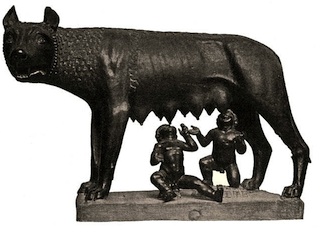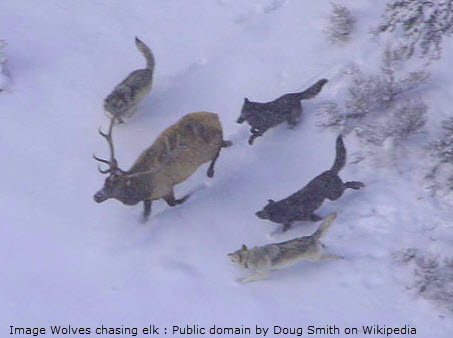Describing communities
 A theoretical lesson to look at the role of organisms in food webs. Beginning with a short explanation of the roles and limiting factors this activity quickly moves to a model community and a challenge for students to build a stable community of organisms. A final activity to research ecosystem roles of local species completes the lesson.
A theoretical lesson to look at the role of organisms in food webs. Beginning with a short explanation of the roles and limiting factors this activity quickly moves to a model community and a challenge for students to build a stable community of organisms. A final activity to research ecosystem roles of local species completes the lesson.
Lesson Description
 Guiding Question
Guiding Question
When wolves were driven out of Yellowstone national park there was less predation of herbivores like the elk. However the biodiversity of the ecosystem decreased. When the wolves were reintroduced the biodiversity increased again.
Can you suggest why this may have happened?
Activity 1 - Roles which species can play in an ecosystem
Introduce the idea of a niche and the roles of organisms in ecosystems using the following Prezi slides:
Activity 2 - Keystone species in a community.
Investigate the feeding relationships in this simple ecosystem model and decide whether the top predator is a keystone species.
See this ![]() Introduction to Ecology lab video to show the setup.
Introduction to Ecology lab video to show the setup.
How to set up the food chains / webs
It is simple to modify the species present in the ecosystem by clicking on them.
you can set the prey/food species too - just clicking them.
Click this link - Ecology lab ecosystem model to open the interactive ecosystem model and try the following activities.
To begin with:
- Try to build a food chain which contains 4 species which all survive until the end of the run.
- State what the conditions for survival were for each species.
- Write down at least three, "what would happen if ..?" questions that have been asked and tested while trialling and improving the model.
More advanced
- Build an ecosystem which has the largest number of surviving species - a) without the top predator, b)with the top predator.
- What have your learned about each community?
- Could the top predator be described as a "Keystone species" - that is a species which has a significant effect on many species in the community. E.g. "A single mountain lion can roam a Canadian forest area of hundreds of miles. The deer, rabbits, and bird species in the ecosystem are at least partly controlled by the presence of the mountain lion."
Record keeping
Complete the ![]() Keystone species ecosystem activity worksheet.
Keystone species ecosystem activity worksheet.
Activity 3 - Local species examples
Keeping records of Local examples to illustrate the range of ways in which species can interact within a community.
Complete the ![]() Ecological roles of local species worksheet.
Ecological roles of local species worksheet.
This sheet summarises the different roles within an ecosystem and will help you keep records of your local environment.
Teacher's notes
For Activity 1
Teachers may wish to include interesting examples of Wolves and starfish as keystone species, more details of limiting factors and specific questions about what the roles of the other species in the ecosystem.
This video (15 minutes) describes the roles that species can have in an ecosystem. It may be useful in addition to the Prezi.
![]() Roles of species in ecosystems which gives some great examples from North America
Roles of species in ecosystems which gives some great examples from North America
For activity 2
This video is ![]() A great example of a food web which leads to rapid extinction of all but one species.
A great example of a food web which leads to rapid extinction of all but one species.
Click the eye icon to see one solution which keeps 5 species alive until the end.

Some good "what would happen if" questions
- What would happen if I just grow the herbivores?
- What would happen if I grow just 2 of the herbivores?
- Which of the herbivores grows the fastest?
- What happens if an omnivore has 2 or more prey?
- What happens if both the omnivores eat each other?
- What happens if the fox eats all types of animals?
This is a nice summary worksheet on Wolves and Starfish from Biology corner. - In case you are looking for more.
https://www.biologycorner.com/worksheets/articles/keystone.html

 IB Docs (2) Team
IB Docs (2) Team
